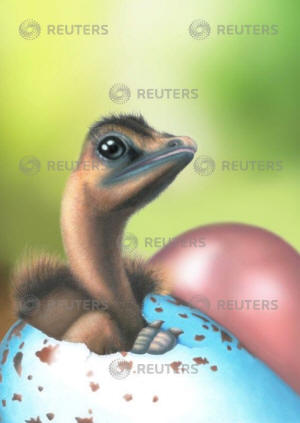|
Some dinosaurs had exquisite eggs with
colors, spots, speckles
 Send a link to a friend
Send a link to a friend
 [November 02, 2018]
By Will Dunham [November 02, 2018]
By Will Dunham
WASHINGTON (Reuters) - Some dinosaurs laid
colored, speckled and spotted eggs boasting exquisite hues of blue and
brown, scientists said on Thursday, in a discovery that scrambles the
notion that such exceptional traits originated with birds.
An analysis of 12 fossilized dinosaur eggshells from Europe, Asia, North
America and South America detected the same two pigments present in
colorful birds eggs in a dinosaur group called eumaniraptorans, which
includes well-known meat eaters like Velociraptor and the small
feathered dinosaur ancestors of birds.
"We discovered that egg color is not a trait unique to our modern birds,
but evolved in their non-avian dinosaur ancestors," said Yale University
paleontologist Jasmina Wiemann, who led the study published in the
journal Nature. "Our study fundamentally changes our understanding of
egg color evolution, and adds color to dinosaur nests in the real
'Jurassic World'."
For example, the sickle-clawed predator Deinonychus had a blue egg with
brown blotches and the bird-like Oviraptor, known for its toothless
beak, had eggs that were dark blue.
Birds evolved from eumaniraptoran dinosaurs in the Jurassic Period. The
earliest-known bird, Archaeopteryx, lived about 150 million years ago in
Germany.
Eumaniraptorans, part of the larger theropod assemblage of two-legged
meat-eating dinosaurs, generally were small and bird-like, covered in
colorful plumage. They included predators up to 30 feet (9 meters) long
and as small as a house cat, but did not include behemoths like
Tyrannosaurus rex and Giganotosaurus.
Egg color provided an evolutionary advantage to dinosaurs that had
exposed nests for their eggs, rather than burying them as alligators and
turtles do, in part by providing camouflage to protect against
egg-eating predators, the researchers said.
All the other dinosaurs studied produced plain white eggs, indicating a
single evolutionary origin of egg color in eumaniraptoran dinosaurs that
was passed on to their bird descendants.
In the eumaniraptorans, the researchers found evidence of a blue-green
pigment called biliverdin and a red-brown pigment called protoporphyrin
IX structurally integrated into the crystal matrix of the eggshell, as
they are with birds.
[to top of second column]
|

An illustration of a hatching Deinonychus chick from a blue egg with
brown spots is pictured in this handout image provided November 1,
2018. Jasmina Wiemann/Yale Univeristy/Handout via REUTERS

"Some were uniformly colored," said paleontologist and study
co-author Mark Norell of the American Museum of Natural History in
New York. "Some were spotted and speckled. It was just like in
living birds. A robin's egg is uniformly blue, but a quail's is
spotted and speckled."

Other traits once assumed to have originated in birds, like feathers
and wishbones, also were inherited from their dinosaur forebears,
Norell said.
(Reporting by Will Dunham; Editing by Bill Berkrot)
[© 2018 Thomson Reuters. All rights
reserved.]
Copyright 2018 Reuters. All rights reserved. This material may not be published,
broadcast, rewritten or redistributed.
Thompson Reuters is solely responsible for this content. |